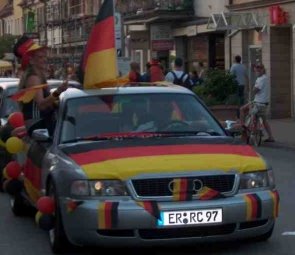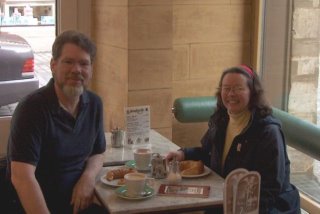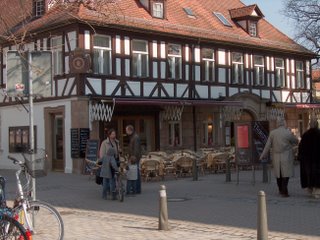First things first: Fußball Fieber (Soccer Fever)!
June 23: Germany over Argentina in the quarter-finals in a shoot out, score: 3 to 1. We watched the game at a beer garden we discovered on a tour of the oldest part of Erlangen. The crowd was mostly around our age, with a few young kids and a couple babies thrown in. German flags were waving, and the excitement was infectious. The game was dragged out into overtime, and ended in a shoot-out where the first team to score two goals more than the other team won. It was a one-on-one situation, where one player tried to get the ball past the other team's goalie. Very suspenseful and exciting. After the game we went to have some ice cream and were witness to a very colorful, impromptu parade given by the teens and 20-somethings in Erlangen. Cars decorated with black, red, and gold balloons and flags, honking their horns, kids draped in flags and wearing silly wigs formed a procession in the main streets, singing soccer songs and chanting and drinking. Every bar in the city was showing the game, and there were a couple of places in the city where you could watch the game on big screens outdoors. Soccer chants: “Berlin, Berlin, we're going to Berlin!” ( to the finals, in other words). To the opposing team: “You can go home now!”


We have a German flag in the window of our apartment. A neighbor asked us why we didn't have an American flag, and I said it was more fun to watch the German team play, because people here were so excited about the whole world-cup thing.
July 4: Germany lost to Italy 0:2 in overtime. No soccer fan riots after the game with Italy, that I heard about. Everything was pretty quiet that night. The game was on late, so we went to bed before it ended. People were very sad about the result. Pictures of the fans at the game showed tears on their faces. Everybody who was rooting for Deutschland was pretty disappointed. The game was well played. I don't think anybody expected the German team to go so far. There's a game on Saturday, where they play Portugal, I think, for 3rd place.
People are saying that the world-cup games were a success for Germany nonetheless. They gained international respect as a friendly and well organized host, and were helped by a wave of self-esteem and patriotism (love of one's own country). They avoided the nationalism (hatred of other countries) that they have feared since the 2nd World War. Around town, there were almost as many Italian, Brazilian, and Argentinian flags and jerseys being displayed and worn as there were German flags. There were discussions on the city buses about the games, people supporting both sides of any game. It was all-in-all a very positive mood everywhere. Richard said, after we watched the Germany-Argentina game in Erlangen, that he had never seen so many happy Germans. We were in the Nuremberg Market Square, where there was a large area with big screens, tables, benches, and food booths set up for fans to watch the games. The vendors had flags from several countries displayed in their booths. The Mexican food vendor had flags of the US, Mexico, and Italy, and there was a Croatian food booth. You could buy teddy bears wearing a soccer shirt with the German or US flag.
The other first priority: Beer
The beer garden where we watched the game belongs to one of the oldest independent breweries in Erlangen. Before the old town burned down in 1706, there were 7 breweries in the old city of 600 people. By the way, Erlangen became a city officially in 1398. In the late 1600s, it was actually necessary to raze the narrow northernmost gate of the city, so that the beer wagons could go through the street two at a time on their way from the cool storage in the sandstone beer caves north of town to the harbor where the beer was shipped to other places in Germany. Beer, as much as religion, has shaped this city. In later centuries, there were as many as 18 breweries here. Today there are two independent breweries in Erlangen. Franken (Franconia) is known for its many independent breweries. Every other town has its own brewery, or two, with its own micro-brews.
Cultural Exchange
One week in May, we went to a concert of German and Turkish music from the time of the Ottoman Empire. The German music (Beethoven, Mozart) was mixed with the Turkish music, with a piece from one culture continuing uninterrupted into the next piece by a composer from the other culture. The similarities were made obvious, and the point was to see how the two cultures influenced each other. Surprising thing was, many of the pieces were waltzes!
A Parade!
One Sunday we went into the center of town, where the Schutzverein (Shooting Club) had its big parade. The Erlangen shooting club was celebrating its 550th anniversary, which happened to coincide with the meeting of all the shooting clubs in Germany here in Erlangen. The parade was entirely made up of people in the old traditional clothing, many carrying guns or bows and arrows, most walking but a few riding horse-drawn wagons full of beer barrels. Groups of old Shooting Clubs came from all over Germany, and some of the businesses displayed signs with bullet holes (the bullet holes bring good luck). There were many marching bands. In my humble opinion, the Germans do marching bands very well! This is the country of the Oom-paa band after all! Almost all the bands wore a form of traditional clothing, and for the most part avoided the ill-fitting uniforms and tacky drum majorettes twirling batons seen so often in the US.




By the way, Lederhosen are more typically Bavarian (present day southern Bavaria) than Frankish. In the picture of the Neunkirchen group, you can see a man wearing knee-length pants which are traditional for this area around Nuremberg.
Erlangen Bergkirchweih – Beer, Again
In Erlangen, everyone looks forward to the Thursday before Pentecost, when the first keg is tapped at the big party called "Bergkirchweih" (see http://www.geocities.com/RainForest/Vines/1357/berg_gb.html) This party is second only to Oktoberfest in Germany, so all of you beer lovers should come for a visit. Beer storage under the hill north of the city in sandstone beer caves, or “Keller” was a must in past centuries, when the caves were a cool 12 degrees Celsius year-round. Hence the rush which resulted in the razing of old Erlangen's northern gate: to get the beer from the caves to the ships in the harbor and on ice as quickly as possible.
To the question about whether people drink beer at work: it's more typical for the Technicians and “handworkers” (skilled laborers) to have beer with lunch than it is for the desk jockeys. Beer is available in the cafeteria. In Richard's engineering office, you can have beer or liquor at your desk so long as you only consume it after 4:30 pm. I am told that it is customary for the women in the extreme eastern part of Franken (a town called Hof) to have beer at lunch time. I have enjoyed more beer than in my entire life before I came to Germany. It's always served cold (but not frosty), and always tastes excellent.
Regensburg, Ancient Imperial City
(written by Richard)
One Saturday we went to Regensburg, which lies on the northernmost tip of the Danube. People have lived here since the stone age, and the Celtic name Ratisbona was the oldest name given to the prehistoric settlement. It became a Roman fort around 90 a.d. The first written documentation of the town was by Roman Emperor Marcus Aurelius in 179 A.D. when it became a garrison in order to prevent Germanic raiders from coming over the Danube.
The Steinerne Brücke was built between 1135 and 1146. This is the oldest stone bridge north of the Alps, and it opened major international trade routes across the Danube between Northern Europe and Venice. The Frankish Kings got really rich in the 12th and 13th centuries.
Johannes Kepler lived here in the early 1600s. Regensburg became Protestant in 1542, so Kepler didn't have the problems that Galileo had in Italy.
In 1663 the old City Hall became the site of the permanent Reichstag or Imperial Diet of the Holy Roman Empire. The houses were taken over by bureaucrats and emissaries, and Regensburg was the seat of Germany's first parliament for 150 years. In the basement is the old dungeon and torture chamber. We visited it before, and the torture chamber makes Kathy feel queasy, so we didn't visit it again.
Instead, we went to the Historisches Museum, or Historical Museum, where we saw artifacts from the ancient Roman times and the Middle Ages. We saw the ancient stone that was above the main gate to the city. The deed for Roman foundation of the Garrison is hewn in this stone.
Then we went to “Document Neupfarrplatz.” The strange name refers to this area's status as an actual piece of archaeology, preserved in order to document the past at the “New Parish Square.” In 1995, the city dug up the large square where the Christmas Market is held in order to install electrical outlets. Archaeologists expected to find relics of the city's 2,000-year history, but they discovered far more than that. Over the next three years, the city's rewiring project became a major archaeological dig that revealed the well-preserved ruins of Castra Regina, the Roman military camp founded by emperor Marcus Aurelius in 179 AD, and the medieval Jewish Quarter including synagogue, which had been torn down and replaced by a church after the town council expelled the Jews in 1519. The usual absurd charges were leveled against the Jews: responsibility for the town's economic decline, ritual sacrifice of infants, and they were requested to vacate the city within 5 days. Always interested in seeing old stones, we went for the underground tour, which included a fantastic film of the history of the city and the Jewish Quarter, with a digital reconstruction of the streets of the Quarter and the Gothic-style synagogue. The tour was made up mostly of middle-aged Jewish people from Allentown, Pennsylvania, who didn't speak much German. The tour guide unfortunately didn't speak much English, so Kathy and I filled in as interpreters. It was the first time that Trewin Whirlwind Tours gave a tour to people other than family and friends.
The Recommended Daily Allowance of Art
We made a day trip to Munich, intending to see the modern art museum. Instead we ended up at the Lenbachhaus Museum of the Blaue Reiter (Blue Rider) group. It's our favorite museum. The Blue Rider group was a group of expressionist painters based around Munich, which included Wassily Kandinsky, and our favorite, Franz Marc. Marc is known for his symbolic paintings of animals and tended toward abstraction toward the end of his life (killed in action in WWI, 1916). The art is very accessible and generally not depressing. There is a café in the museum that serves a dessert that I believe God himself came up with. It's called “Topfenmohnstrudel”. It's like a soufflé, eggy and sweet, with plenty of sweet, poppy-seed filling, with thin layers of dough between the eggy layers. I get this dessert every time it's available.
I love Zurich in the Springtime
On the last weekend in May, we visited Stefan and Sereena in Switzerland and had an excellent time. Stefan collects wine, so a wine tasting was in order. An Alsace Gewurztraminer, a French Bordeaux, and an Italian red challenged our ability to apply adjectives. We toasted our 11th wedding anniversary with a Moet and Chandon champagne.
We ate and drank our way around Luzern and Zurich in very good company. In Luzern (aka Lucerne), we had typical Swiss wurst (sausage) and good beer at the Rathaus (pronounced Raaht-house: City Hall). The brew is special to the Rathaus, and was light and very easy to drink.
We had the pleasure of trying raclette, on a genuine, old fashioned teflon-coated electric grill, the way it's been made for centuries. Seriously, we tried authentic Swiss raclette for the first time at Stefan's. Traditionally, raclette was made by holding a chunk of cheese up to the fire until it melted and dripped onto a plate of food or a piece of bread. Raclette, like fondue in the US, is enjoying renewed popularity in Germany and Switzerland, and is a great excuse to eat a lot of cheese. One puts a slice of special cheese and other ingredients, such as boiled potatoes, slices of ham, gherkins, or mushrooms on a small tray and puts it under the hot surface of the grill (like a griddle with ridges, really). While that's heating up, one puts small sausages, onions, pieces of beef or chicken, on top of the grill. When the cheese has reached a liquid state, you peel it off the little tray, and add the other grilled things to it. Eat, preferably with a view of the local mountains on a crystal clear spring evening. Repeat until the wine or beer is gone, or you've run out of silly stories to tell.
July 4: What I miss about America
I miss American TV. Specifically the voices of the ethnic diversity on TV. There is a lot of diversity here in Erlangen. We are by far not the only foreigners. Turks in abundance, Czechs, Poles, Russians, Indians, Asians (Thai, Chinese, Vietnamese), French, Spanish, Italians, various sorts of Africans: all of these groups I have seen or heard on my travels through town. But, as I don't understand much of the German TV shows, and watch mostly documentaries on the public TV channels, I don't get a flavor for the presence of these groups in the country. So I miss American TV and movies where the rednecks, Hispanics, African-Americans, Asians, gays, and Jewish people all contribute humor to sitcoms and movies. I don't mean these groups are funny in themselves – I just like the way they can laugh at themselves. Mel Brooks, for example. Billy Crystal. Eddy Murphy. Chris Tucker to Jackie Chan in “Rush Hour”: “Don't mess with a black man's radio!” (Parallel: “Don't mess with a German man's beer”, as Richard was, in effect, warned when he stepped too close to a drunk's brewski). George Lopez's show, which I didn't watch at all. Will and Grace. Frasier (OK, almost no minorities, but clever TV). I miss the humor, I miss the crass silliness. Richard gave me the DVDs of the third season of Northern Exposure for my birthday. The tension between the expectations of a Jewish doctor from New York, and the easy-going eccentrics in town is the foundation of that show.
Next time...
A report on our day-trip to Dinkelsbühl, a medieval walled city where we enjoyed local seasonal specialties.





